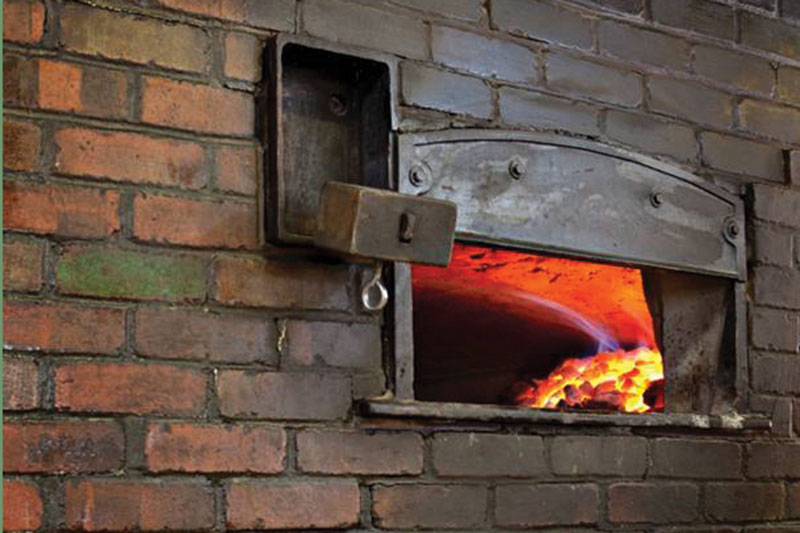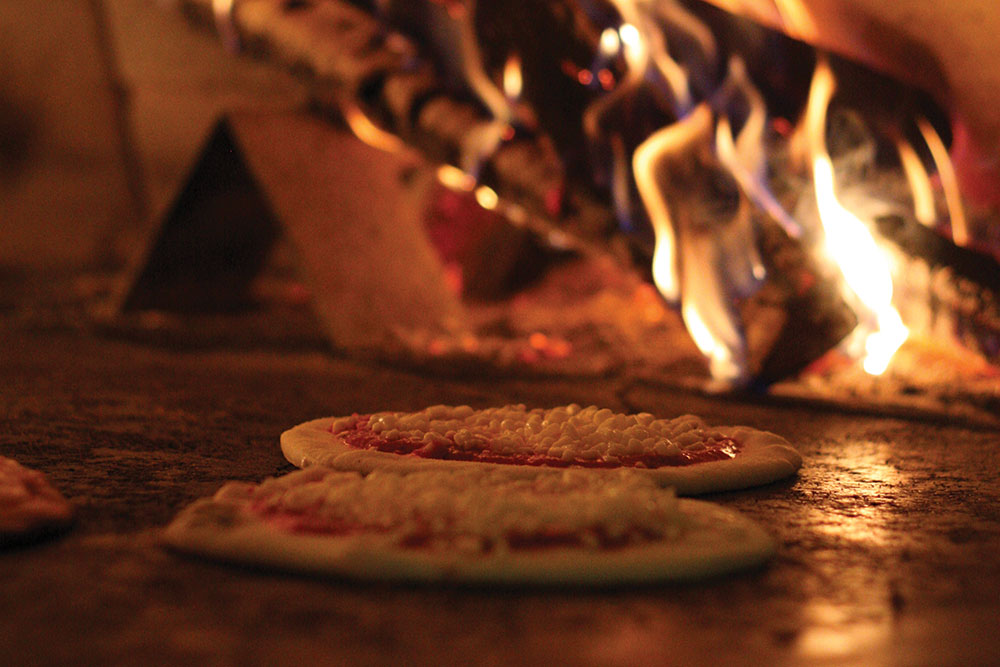From firing up pizzas over a bed of black-diamond coal to rotating authentic Neapolitan pies in wood-burning ovens, many operators today have embraced labor-intensive cooking methods that require the utmost care and specialized know-how. And, with more customers today demanding foods that tout a handmade touch, these operators are attracting legions of fans who appreciate cooking methods that seem both familiar and unexpected.
However, the nature of this approach dictates that operators and their staff members know some tricks of the trade. We tapped experts who have found success with wood- and coal-fired pizzas to share their insider tips—and explain how these styles of pizza can provide an appreciable marketing advantage.
The Neapolitan Tradition
Neapolitan pizza requires both special equipment—such as a wood-burning oven direct from Naples—and special expertise. At A Mano (amanopizza.com) in Ridgewood, New Jersey, employees use hard wood (which burns slower and more consistently than soft wood) that is dry and cut into small pieces—no more than 5” in diameter, according to Dana Stott, owner of DLS Public Relations, which represents A Mano. A local landscaping company cuts the wood, which costs about $225 per cord.
“Working with wood-fired ovens from Naples, it’s important to use a strong, hard wood, like apple, cherry or birch,” according to Roberto Caporuscio, owner of Kesté Pizza & Vino (kestepizzeria.com) in New York and Don Antonio by Starita (donantoniopizza.com), with locations in New York and Atlanta. “Our supplier, from New York State, dries wood in a special machine so it’s clean and dry for cooking.” Caporuscio, whose wood does double duty by also cooking pasta dishes, says he uses about 40 bundles per week.
In addition to proper wood selection, Caporuscio stresses the importance of oven style. “An oven from Naples has a stone inside that holds heat—an oven that is not well-insulated will lose temperature—while the dome is low and the mouth allows for control,” he explains. He also advises balancing the temperature of the floor and interior. To test oven temperature, pizza makers can check how long a pizza takes to cook; if the dough is still white after baking for a minute, more heat is necessary.
At Kesté, heating the oven takes about 45 minutes at the start of the day. Stott notes that properly heating a wood-fired oven is a common obstacle for novice operators. “Often, it’s assumed a cold oven can be heated quickly by simply building a fire inside, but the bricks absorb a tremendous amount of heat and therefore need a steady supply of energy to get warmed up and remain hot,” Stott says. “Once the ovens are heated through, they hold temperature well by simply adding wood as necessary.” Based on the fire and pizza performance, A Mano’s pizza makers know how often to add wood to the ovens, maintaining a consistent 800°-to-900°F temperature.
During the prep and cooking process, Caporuscio stresses communication between the pizzaiolo (pizza maker) and fornaio (pizza baker), who must manage temperature and pay constant attention to the pies. “An important tip: Place the pizza on the stone, let it begin cooking, then lift it, bringing it to the mouth of the oven,” Stott advises. “Turn it outside of the heat and place it back on the same spot it was taken from. Turning it outside the oven (at the mouth) prevents burning, and placing it back on the same spot means you won’t drop it onto a hotspot, where you risk burning the bottom. This allows for a more even bake.”
Unfortunately, the act of placing a pizza in a hot oven lets heat out, so Caporuscio suggests putting in no more than three or four pizzas at a time; any more will slow down the oven. Other tips from the master pizzaiolo: Neapolitan pizzas should be golden, not excessively charred; avoid using too much flour on the dough, which can burn the pizza; and don’t leave the pizza in the oven too long (this creates a crunchier crust, which is not desirable for the Neapolitan style).
Dual-ing Ovens
The chefs at Brixx Wood Fired Pizza (brixxpizza.com), based in Charlotte, North Carolina, choose hickory and oak woods for their great burn and natural flavors. But as the pizzeria’s cooking style evolved, the business transitioned to a dual-fuel wood/gas oven. “Starting the wood-only oven first thing in the morning to raise the floor temperature is most important,” notes Richard Shinault, executive chef at Brixx. “The dual-fuel ovens require time to heat up, but the proper temperature is achieved more quickly and is easier to maintain than wood only—and maintaining temperature is crucial to having a consistent product.”
The pizzeria also uses the ovens to cook its focaccia bread and wood-roasted chicken. In all cases, Shinault says, proper oven management is a must to prevent an uneven bake. “The ovens have hotter sides toward the wood coals,” he explains. “Use a peel to rotate the pizza throughout the baking process to perfect the entire crust and get an even, crisp pizza.”
Mark Dym, the owner of Marco’s Coal Fired Pizza (marcoscoalfiredpizza.com), with locations in Denver and Englewood, Colorado, also incorporates dual fuels in his operation, running both a wood-burning oven (which uses hickory) and a coal-burning oven (which uses anthracite) in his pizzerias. He prevents excessive cooling by placing a door over the mouth of the ovens before closing each night. Then, in the morning, he puts five pieces of wood in the wood-burning oven and lets them sit for about an hour before lighting. “This gives the wood an hour to really dry out, and I use the same process with my coal oven,” Dym notes. “Oven maintenance throughout the evening comes with practice. You need to get a feel for the oven. I tell my guys the oven has a mind of its own sometimes!”
While some pizza restaurants use more than one fuel source, Scottsdale, Arizona-based Grimaldi’s Coal Brick Oven Pizzeria (grimaldispizzeria.com), with 33 locations, is dedicated exclusively to anthracite coal, often called “black diamond,” for its signature pies. Corporate chef Cory Lattuca notes that this hard, compact variety of mineral coal has a high luster, the highest carbon content, the fewest impurities, and the highest calorific content of all types of coal.
The Grimaldi’s ovens are designed and built by hand—weighing in at 25 tons and heated by 100 lb. of coal per day to reach temperatures of up to 1,200°F. “The intense heat of the oven evenly bakes the pies to create our famous crispy and smoky thin crust, and we stoke twice daily to ensure our ovens stay hot,” Lattuca says. “Our employees train for months in order to be able to perfectly cook over the coal-fired flame.”
A Marketing Advantage
Incorporating coal- and wood-fired cooking may require time, training and passion, but pizzeria owners who use these methods find that they offer a natural marketing angle for customers who crave an artisanal touch. “Wood-fired ovens attract plenty of customer interest,” Stott observes. “The tables in front of A Mano’s ovens are the most popular. Although wood-burning ovens are becoming more commonly seen, they retain a measure of authenticity and natural simplicity—crucial for a Neapolitan concept.”
Caporuscio, noting the importance of giving customers a compelling visual, went a step further for his latest concept, Don Antonio by Starita: He installed cameras by the prep/cooking areas so that customers can watch his pizza makers hard at work on TV sets around the restaurant. Meanwhile, smartly positioned bar seats allow select patrons to see the process up close.
At Grimaldi’s, coal-fired ovens also add to the overall decor and ambience. “Centered in the middle of our restaurant and visible to the public, we ensure our hand-built brick ovens are the centerpiece,” Lattuca says. “The coal brick oven is in our name, and it’s the first thing we build out in any restaurant.”

Similarly, at Brixx, the oven is at the heart of the concept—and at the heart of the entire restaurant design. Locations are set up so that the oven is aligned with the front door, placing it in view of everyone who enters. And Tim Miner, director of marketing for Brixx, believes there are many advantages to having open kitchens in all locations. “These days, our guests want to know where their food comes from, and we’ve got a great story to tell—and demonstrate—about our pizzas,” says Miner. “Our guests can watch us create pizzas step by step and see the quality of the ingredients we’re using. That excites them—and us!”
In fact, Miner adds, most Brixx locations offer an element of interaction with guests, thanks to a special window that shows the side of the oven. “Guests, especially kids, are encouraged to watch us build each pizza from scratch, and our pizza chefs love to interact with guests,” he says. “They take pride in their work and enjoy that our guests can see how much care they take to make each pizza.”
Dym also loves the interaction that such cooking methods can provide and gives frequent tours to customers, who are invariably impressed to see pizzas cook in only 90 seconds. “They love coming in the kitchen when we’re busy and watching the action,” Dym says, with a laugh. “I love the kids’ faces when they’re watching us make pizza!”
In today’s fast-paced, prepackaged world, customers are increasingly looking for food that’s made with a little love—and if there’s one food that’s ideal to display the passion of its makers, it’s pizza. Coal- and wood-burning ovens placed front and center won’t be possible for every pizzeria, but those who have embraced these less-common cooking methods have often found amazing results—and increased customer interest. As Caporuscio says, “The beauty in pizza is seeing the maker work.”
| Words of Warning |
For all of their many advantages in a pizza operation, wood- and coal-fired ovens also pose some challenges. Tom Lehmann, director of bakery assistance for the American Institute of Baking in Manhattan, Kansas, offers some tips:
|















